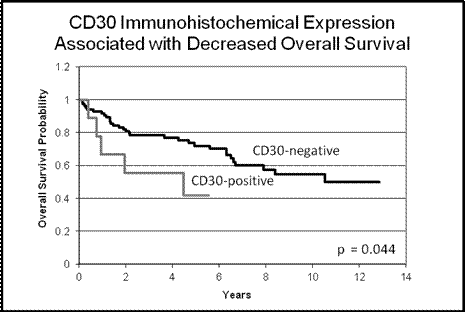Abstract
Diffuse large B-cell lymphoma (DLBCL) is a heterogeneous disease entity with multiple potential prognostic biomarkers. Cell of origin (COO) molecular subtype classification using gene expression profiling with microarrays and immunohistochemical expression of CD30 have been examined as potential prognostic markers, often with conflicting results. A recent study demonstrated that patients with CD30-positive DLBCL had better prognosis compared to patients with CD30-negative DLBCL and had a distinct gene expression profile (Hu S et al. Blood. 121(14): 2715-24, 2013). In addition, due to the development of targeted therapies such as an anti-CD30 monoclonal antibody drug conjugate, the identification and prognostic relevance of this biomarker has potential therapeutic impact. We evaluated CD30 expression, determined by immunohistochemistry, in a cohort of de novo DLBCL cases at our institution and examined cell of origin molecular subtype in the CD30-positive and CD30-negative groups.
94 adult patients with de novo DLBCL uniformly treated with rituximab, cyclophosphamide, doxorubicin, vincristine and prednisone (R-CHOP) as first line therapy were identified at The Cleveland Clinic. Clinical data was collected for these patients. A tissue microarray was created and stained with antibodies to CD10, CD20, CD30, BCL-6, and MUM-1. COO subtype was determined for the Hans algorithm in all cases. CD30 was considered positive when expression was seen in ≥ 20% of tumor cells.
There were no significant differences in sex, age, IPI score, or stage between patients in the CD30-positive and CD30-negative groups. The median age of the DLBCL cohort was 63 years (range 17-91 years) with a male : female ratio of 1:1.1. 54% of patients had stage III or IV disease. Median follow-up was 58 months. 9 of 94 DLBCL samples (9.6%) were positive for CD30 by immunohistochemistry. By Kaplan-Meier analysis, the CD30-positive cases showed a decreased overall survival compared to the CD30-negative cases (Figure 1, p=0.044). Multivariate analysis using a Cox proportional hazard model confirmed that CD30 expression was independent of IPI and a significant factor for overall survival (hazard ratio = 3.05; 95% confidence interval = 1.12-8.30; p = 0.0291). All 9 of the CD30-positive DLBCL samples were of the non-germinal center B-cell-like (NGC) subtype using the Hans immunohistochemical algorithm, which was significantly more than the CD30-negative samples (42/85) (p = 0.003).
CD30 expression was associated with poor prognosis in our cohort, in contrast to recent studies. However, CD30 expression was highly associated with the NGC subtype of DLBCL and might contribute to the pathogenesis of these lymphomas through NF-κB activation. Given the poor prognosis of NGC DLBCLs, targeting CD30 in DLBCL should be explored.
No relevant conflicts of interest to declare.
Author notes
Asterisk with author names denotes non-ASH members.


